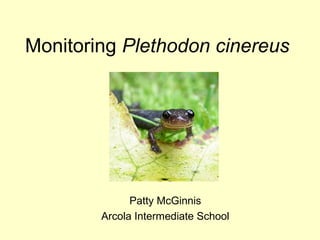
Salamander presentation
- 1. Monitoring Plethodon cinereus Patty McGinnis Arcola Intermediate School
- 2. Identification • Completely terrestrial • Abundant • 5.7-12.7 cm • Redback phase is gray or black body with a red stripe down its back • Leadback phase lacks the red stripe • Belly is mottled white and gray • 16 to 19 costal grooves • 5 toes on hind feet, 4 on front • Male and female identical in appearance
- 3. Range • Eastern North America • Range extends west to Missouri, south to North Carolina and north from southern Quebec and the Maritime Provinces in Canada to Minnesota
- 4. Habitat • Mixed Deciduous Forests • Completely terrestrial • Absorbs moisture through skin • Prefers humid, shady areas • Found underneath leaf litter, under rocks, logs, and in burrows • Negatively affected by high levels of acidity in soil • Decreased moisture limits range to under rocks or burrows • Over winter by burying below frost line
- 5. Food • Consume mites, spiders, insects, centipedes, millipedes, beetles, snails, ants, earthworms, flies, and insect larvae • Capture prey with out-thrust tongue • Forage during and after rains • Can store fat to survive during dry conditions
- 6. Prey • Prey to snakes, birds, mammals • Will drop all or part of their tail if attacked (regrown tail is lighter in color)
- 7. Niche • Play an important role in ecosystem by providing food for others and by eating large numbers of invertebrates • P. cinereus biomass is larger than mammals and birds combined
- 8. Lifespan • No research on P. cinereus • P. jordani can live up to 32 years with an average of 9.8 years (Hairston, 1983)
- 9. Reproduction • Mate in fall • Male deposits spermatophore • Female picks up spermatophore with cloaca • 3 to 14 eggs are laid in spring in cracks or crevices; female guards eggs until they hatch • Slime secreted by female keeps eggs moist • No aquatic larval stage • Eggs develop directly into young salamanders • 2 years to maturity
- 10. Behavior • Are solitary • Exhibit territoriality to protect food supply • Capable of threatening displays • Scent marks and fecal pellets are left by both sexes • Cues tell territory, size and sex, identify of resident • Salamanders recognize relatives through smell • Juvenile kin are sometimes allowed to feed in an adult’s territory
- 11. Conservation Status • Abundant, not threatened • Serve as bioindicators • Impacted by clear cutting, fungal diseases, acid rain • Do best in closed canopy forests
- 12. Cover Boards • Provide artificial cover through arrays of cover boards • Plywood or particle board, 2’ x 2’ in size • Boards should not be dry or new • Place along transects • Number the boards with spray paint • Place flagging on nearby tree or use GPS to mark location
- 13. Monitoring Plots • 1 m X 1 m plots • Cover boards are at least 5 m apart • Salamanders are captured and measured. Some studies mark them using Visible Implant Elastomers (VIE) • Search cover boards every 2-3 weeks from April through October/early November • Other data can include vegetation identification, litter levels, decomposition, soil temperature and moisture • Leaf litter sample to identify invertebrates (Berlese funnel)
- 14. Checking Boards • Use a stick to turn board towards you • Always be aware of snakes • Release salamander next to board
- 15. Collecting Data on Salamanders • Snout to Tail Length, Weight, Species Identification • Mass is taken with a spring scale • Salamanders are placed in baggies • Can be kept in refrigerator for several days if necessary
- 16. Handling Salamanders • Handle as little as possible • Make sure hands are free of soaps and lotions • Can wet hands with spring water or dampen hands with soil
- 17. Salamanders and Students • P. cinereus makes a good test subject • Numerous • Easily found and handled • Inquiry experiments can be developed using cover boards in different locations
- 18. References • http://www.ccari.org/crccbp/literature.htm • dnr.wi.gov/.../eek/critter/amphibian/index.htm • http://animaldiversity.ummz.umich.edu/site/accounts/information/Ple thodon_cinereus. • htmlhttp://www.biokids.umich.edu/critters/Plethodon_cinereus/ • http://www.bioone.org/doi/abs/10.1656/045.016.0101 • http://www.invasiveplants.net/impsal.htm • http://www.caudata.org/cc/species/Plethodon/P_cinereus.shtml
